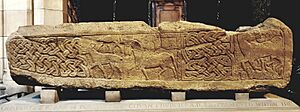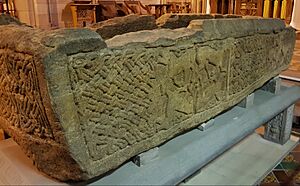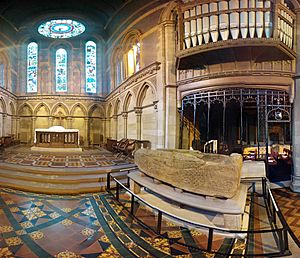The Govan Stones facts for kids
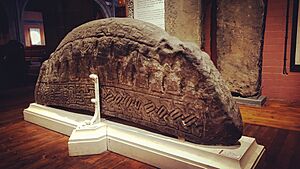
The Govan 2 hogback in Govan Old Parish Church
|
|
| Location | Govan |
|---|---|
| Coordinates | 55°51′53″N 4°18′46″W / 55.8646°N 4.3129°W |
The Govan Stones are a really important collection of old carved stones. You can see them at Govan Old Parish Church in Glasgow, Scotland. These stones come from the churchyard, which is about 1,500 years old.
The collection includes the Govan Sarcophagus, five special Viking-style 'hogback' stones, four standing crosses, the 'Govan Warrior' carving, and many flat grave markers. Most of these stones were made between the 800s and 1000s AD.
Govan Old and the Govan Stones museum are open every day from April 1st to October 31st, from 11 AM to 4 PM. It's free to visit, but you can make a donation. There's also a gift shop that helps raise money to look after the church and its amazing collection.
Contents
- What Are the Govan Stones?
- A Look Back: History of the Stones
- How the Site Began
- The Govan Sarcophagus: More Details
- Govan Hogbacks: Viking-Style Stones
- Crosses and Standing Cross-Slabs
- Flat Grave Markers
- Why the Govan Stones Are Famous
- The Govan Warrior: A New Discovery
- The Govan Stones in the News
What Are the Govan Stones?
These carved stones were likely made to celebrate the power of the rulers of the Brittonic Kingdom of Strathclyde. This kingdom was part of a larger area called Yr Hen Ogledd, or 'The Old North'.
About 45 stones were known in the 1970s. However, 14 flat grave markers that were outside the church were thought to be destroyed in 1973. This happened when a nearby shipyard building was knocked down, and the old stones were accidentally mixed up with the rubble.
But in 2019, a 14-year-old schoolboy named Mark McGettigan found one of these 'lost' stones! He was helping with a community project called ‘Stones 'n' Bones’. After that, two more flat grave markers were found. This gives hope that even more of the original 14 stones might still be hidden.
As of 2025, people are still digging in the Govan Old graveyard, which is about 1,500 years old. Teams led by Professor Stephen Driscoll from the University of Glasgow and Clyde Archaeology are finding new carved stones from the early medieval period.
One exciting recent find was a piece called the 'Govan Warrior'. It was found in September 2023 in a part of the graveyard where an old gravel road from the early medieval period is being uncovered. In 2024, another piece was found. It had a pattern called 'median-incised interlace', which is common on other Govan Stones, like the Sarcophagus.
The stones you can see today include the Govan Sarcophagus, five hogback stones (which are a Viking-style from England), four standing crosses, and 21 flat grave markers.
The Govan Sarcophagus: A Special Coffin
The most important stone in the collection is the Govan Sarcophagus. This is a large stone coffin. People think it was made to honor St. Constantine, who was the son of a Pictish king named Kenneth MacAlpin. It has carvings of a stag hunting scene, like those found in Pictish art, and different animal designs.
The sarcophagus is carved from a single piece of sandstone. It's the only one of its kind found in northern Britain from before the Normans arrived.
A Look Back: History of the Stones
The Govan Stones date back to the 800s to 1000s. This was a time when Vikings often raided the Clyde area. Old records, like the Annals of Ulster, say that Vikings destroyed the main fort of the Clyde Britons at Dumbarton Rock in 870 AD. This fort, called Alt Clut, was very important. The Vikings attacked it for four months.
After the king of Alt Clut, Artgal, was either killed or captured by the Vikings, Govan became very important. Govan and Partick, which are further up the river, became the new centers for the Kingdom of Strathclyde. Govan was already an old Christian site, with burials dating back to 450-600 AD. It became a key religious place for this new kingdom.
The five 'hogback' stones found in Govan suggest that Vikings might have settled or had a strong influence in the areas around the Clyde and Leven rivers after 870 AD. These large sandstone blocks look like Scandinavian longhouses. They are mostly found in parts of northern Britain where Vikings settled. The hogback stones in Govan are some of the largest ever found.
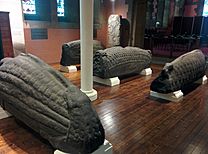
Professor Stephen Driscoll from Glasgow University said that these stones show how the British kingdom of Strathclyde had strong links with the Scandinavian world. He believes the hogbacks were meant to look like a lord's or chieftain's hall.
The Govan Sarcophagus was found in the churchyard in 1855 while someone was digging a grave. To protect the stones from weather, they were moved inside the church in 1926. Before that, they had been in the churchyard for over a thousand years.
How the Site Began
People believe that Christian activity at Govan started around the 400s or 500s AD. Digs in the 1990s found two early Christian burials under an older church. These burials were dated to between 435-601 AD and 474-601 AD.
Govan became very important in the 800s and 900s. There aren't many old writings about Govan from before that time. However, one old book, Historia Regum by Symeon of Durham, mentions the Northumbrian army returning from 'Ovania' after attacking Dumbarton Rock in 756 AD.
Originally, the Annals of Ulster recorded Dumbarton Rock as the main place for the Brittonic Kingdom of Alt Clud from the 500s until the late 800s.
In 870 AD, the Annals of Ulster describe a Viking attack on Dumbarton Rock. After this, the kings of Clyde Rock are no longer mentioned. In 872, the Annals of Ulster start talking about the kingdom of Ystrad Clud, which is better known as the Kingdom of Strathclyde. This shows that power likely moved from Dumbarton Rock to Govan.
The large size of the graveyard and the many early medieval sculptures suggest that the church was supported by royalty. Because the site has been used continuously for so long, it's hard to know what the first church looked like. But digs in the 1990s found the foundations of a wall next to the current building. These foundations, made of boulders, likely supported an early medieval wooden church.
The Govan Sarcophagus: More Details
The Govan Sarcophagus is a huge stone coffin with beautiful carvings on the outside. It was found again in December 1855 when a church worker was digging a grave. It was surrounded by tree roots.
No human remains were found inside the sarcophagus. People think it was buried earlier to protect it, maybe during the Scottish Reformation when religious images were often destroyed. Today, the sarcophagus is a main display in the Govan Stones museum.
It's believed the sarcophagus was dedicated to St Constantine, the church's patron saint. There's a lot of discussion about which Constantine it was, but most experts think it was likely for Causantín mac Cináeda (who lived from 862–877 AD) or Donald f. Constantine (889–900 AD).
Because it's so decorated, it's thought the coffin was meant to show the saint's remains as a central piece in the church.
The coffin's carvings show designs from the Irish Sea Region. One side of the sarcophagus shows a hunting scene with a horseman chasing a stag, possibly with a dog. This type of scene was common in Pictish art and showed royalty and power.
The sarcophagus also shows an animal stepping on two other creatures: a snake and possibly a wolf. The sharp, angled design of the winning animal makes many experts think it's a 'Lamb of God' symbol.
Two other panels on the sarcophagus show beasts in different ways. In one, four 'beasts' are almost mirrored, but each has unique details. In the second panel, two long-necked animals cross their necks and weave their tongues or ears with the other beast's tail. Similar designs, where animals cross body parts, are also seen in Pictish sculptures.
The rest of the sarcophagus is covered with panels of 'median-incised interlace'. Some of these patterns look like snakes, which is a common design in old carvings and is thought to symbolize death and new life.
Govan Hogbacks: Viking-Style Stones
There are five hogback stones at the Govan Stones museum in Govan Old Parish Church. The earliest one, Govan 2, is thought to be from the early 900s. The other four hogbacks are believed to be from later in the 900s.
The five hogbacks at Govan Old are known as Govan 2, Govan 3, Govan 4, Govan 5, and Govan 6. All of them were found in the old churchyard of Govan Old.
- Govan 2 is the smallest (2 meters long) and probably the oldest of the Govan hogbacks. It was loaned to the British Museum in 2014. It has two rows of carvings that look like roof tiles, with curved lines. Below these rows, there's a band of interlace patterns. The pattern is different on each side and isn't continuous. This is the only Govan hogback with 'stopped-plait interlacing', which means small, separate elements with little dots. It also has a 'running ring-knot interlace' with frets.
- Govan 3 was re-carved at some point, likely still in the early medieval period. The re-carving made it look like a single large beast. It might have originally looked like the Brompton hogbacks, with big beasts holding the ends of the stone. Govan 3 is very large. It has a full, 3D animal at one end that stretches across the stone.
- Govan 4 was also re-carved, quite roughly, to look like a single beast. It also has one animal at its end. The animal's head faces outwards, which is unusual for hogbacks. Its four bent legs point towards its head. The top of the stone looks like a spine, and the rows of carvings look like scales.
- Govan 5 has a pair of gripping beasts on the panels at both ends, though one end is very worn. Traces of Govan-style interlace surround these panels, which might be the backs of the beasts. There's a noticeable round dip in the middle top of this stone, which seems to have been made after the early medieval period. The carvings that look like wooden roof shingles or tiles are in good condition on this hogback. Govan 5 has two end-beasts, one at each end. Their faces and bodies are shown from the side with open mouths, and their legs cross at the bottom. This is the only known hogback with end-beasts in this position.
- Govan 6 is very worn down, probably because it was exposed to the weather for a long time. Its roof-tile carvings are unique, with curved sides. Even with the wear, one end seems to have a dragon- or snake-like beast facing outwards from the top. A similar design might have been on the other end, but it's gone. This might be because it was removed or re-carved, like Govan 3 and Govan 4, to make the whole hogback look like one big creature. It is 2.4 meters long.
Crosses and Standing Cross-Slabs
Two cross-shafts and two upright cross-slabs are also on display in the museum.
The cross-shafts include the Govan Cross, also called the 'Jordanhill' Cross, and the Inverted (or Upside Down) Cross. These would have been decorated on all four sides. When complete, they would have been part of a free-standing cross, similar to the Barochan Cross now in Paisley Museum.
The Govan Cross is often called the Jordanhill Cross because it was given to the people of Jordanhill House when one of the churches was being replaced. It was brought back to Govan Old in 1928. The cross has different types of 'median-incised interlace' patterns. Its most interesting feature is a worn carving of a man on horseback. Most of the details are gone, except for the eyes of both the horse and the man.
The ‘Inverted’ or ‘Upside Down’ cross is named that way because it is currently displayed upside down next to the hogback stones in the church. Most of the details on the front of the cross are damaged or worn away. However, the two side faces are quite well preserved. These are mostly decorated with 'median-incised interlace'. They also have the only human carving that might be a Bible scene – possibly David being anointed by Samuel.
The two upright cross-slabs are called the Sun Stone and Cuddy Stane. The Sun Stone is very worn, but it has a large round shape with four snakes coming out of it, making it look like a sun. Below this is a panel with angled interlace. On the other side, it has a cross, interlace, and a rider. Even though there's a small peg on top, some experts think it was too small to hold a stone cross-head. This might mean the Sun Stone was part of the church building.
The Cuddy Stane gets its name from the rider's animal, which looks more like a donkey ('cuddy' in Scots language) than a horse. The stone has been damaged since it was drawn in 1856. That drawing showed the rider's upper body, likely with a sword and a ponytail (which is also seen on the Sun Stone, the Govan Sarcophagus, and the Govan Warrior), and the peg for the cross-head. Today, the stone looks plain because it's very worn. It was also reused as a grave cover later, with carved initials. But you can still see hints of an interlace pattern under the horseman.
Flat Grave Markers
The flat grave markers, called 'recumbent cross-slabs', make up the largest part of the Govan Stones collection.
21 of the original 37 recorded markers are on display, placed around the inside walls of the church. Sadly, these stones haven't received as much attention as the others because they are very worn and have been reused many times since at least the 1600s. This is surprising, as similar flat markers were placed in very important spots at the Christian center on Iona, showing their significance there and, by extension, at Govan.
While these grave markers vary in size, shape, and decoration, they share some common features. Each has a cross with a carved border, which always divides the stone into at least two sections. Each stone also has a plain border around its edge. Finally, at least five of the 21 flat grave markers on display show a special feature called 'angle-knobs', which are important in this region.
Why the Govan Stones Are Famous
The British Museum showed how important the collection is when they borrowed one of the hogback stones for their exhibition Vikings: Life and Legend from March to June 2014.
In August 2017, the Govan Stones were voted Scotland's best 'hidden gem' in a national competition. They received over two thousand votes! They are truly considered important worldwide.
The Govan Warrior: A New Discovery
In September 2023, a previously unknown early medieval carved stone was found by Professor Stephen Driscoll. He found it while re-digging an area he had first explored in 1996 for the TV show Time Team.
This stone is different from the other early medieval carved stones because it has light carvings. Even though it's damaged, it shows what looks like a warrior. The figure has a small, round shield held over their shoulder with a strap. The person also seems to be carrying a staff, spear, or sword resting on their left shoulder. Much of the face is damaged, but it appears to have a pointed beard and a ponytail. The ponytail is also seen on other stones in the collection.
Because of where it was found and its warrior-like features, the figure has been nicknamed the "Govan Warrior".
Students from the University of Glasgow Archaeology department, Clyde Archaeology, and community volunteers helped with the digs and surveys.
The Govan Stones in the News
The Channel 4 archaeology TV show Time Team dug in the graveyard of Govan Old in 1996. This was shown in the fourth episode of series 4 in early 1997.
In March 2019, community archaeologists and the schoolboy Mark McGettigan announced the discovery of long-lost medieval stone carvings. These stones were thought to have been destroyed by accident when the nearby Harland & Wolff shipyard building was demolished in the 1970s.
Professor Stephen Driscoll said, "This is the most exciting discovery we have had at Govan in the last 20 years. The Govan Stones are a collection of international importance, and these recovered stones prove that Govan was a major center of power in the early medieval period."
In September 2023, the discovery of the 'Govan Warrior' was big news across many media outlets. It was featured in newspapers like The Scotsman, The Herald, and the Evening Times, in British Archaeology magazine, and on the BBC Scotland news program, The Nine.
In January 2024, the Govan Early Medieval Podcast (GEMcast) started talking about the Govan Stones and the early medieval Kingdom of Strathclyde. In July 2024, Current Archaeology magazine listed the podcast in its 'What's On' section.


